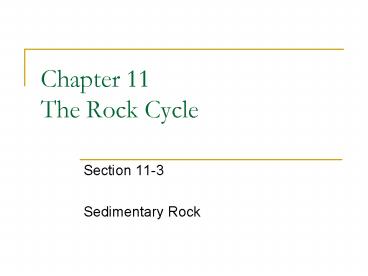Chapter 11 The Rock Cycle - PowerPoint PPT Presentation
1 / 12
Title: Chapter 11 The Rock Cycle
1
Chapter 11The Rock Cycle
- Section 11-3
- Sedimentary Rock
2
I. How do Sedimentary Rocks form?
- Formed from sediments
- Weathering
- Breaks rocks or remains of plants and animals
into smaller pieces called sediments. - Erosion
- Sediments are transported to new locations by
water, wind, ice, and gravity (transportation and
deposition)
3
- Deposited sediments can sometimes recombine to
form solid rock. - Formation of sedimentary rock
- Many layers of sediment are deposited
- Pressure from upper layers pushed down on the
lower layers - Sediments compress together to form rock
- Compaction/Lithification
4
- Sediments can also form rock by
Cementation/Lithification - Layers of sediment accumulate
- Water is squeezed out from all of the pressure
mineral deposits remain - Minerals crystallize and cement together to form
rock
5
http//sln.fi.edu/fellows/payton/rocks/create/sedi
ment.htm
6
II. Classifying Sedimentary Rocks
- Can be made of any type of weathered and eroded
material - Can be plants and/or animals
- Need to look at the sediment they contain and how
they are formed.
7
C. Detrital Sedimentary Rock
- Made of broken pieces of other rock
- Product of weathering
- Compacted and cemented (lithification)
- Can be large and rounded sediments
- Can be large sediments with sharp angles
8
- Shale does not need a lot of cementation to hold
particles together - Has clay sized minerals
9
- Sandstone is formed from quartz and feldspar.
- Sand is deposited in layers
10
D. Chemical Sedimentary Rock
- Formed from dissolved minerals
- Were once chemical compounds
- Becomes concentrated when the water evaporates
- Rock Salt is formed when halite is carried in an
ocean or lake. As the water evaporates, the
concentration of the element increases
11
E. Organic Sedimentary Rock
- Contain large amounts of once living things
(fossils) - Limestone si made of calcite, it also contains
fossils of aquatic animals - When mussels and snails die, their shells build
up on the ocean floor, they compact and become
cemented together and form rock.
12
III. The Rock Cycle
- The process by which rocks change
- All rocks are formed by this cycle
- Rock Cycle Website
http//www.learner.org/interactives/rockcycle/inde
x.html































